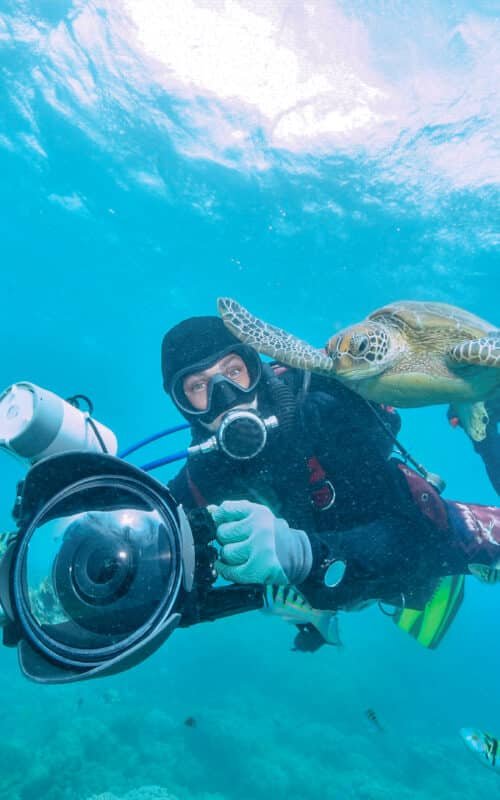Capturing the vibrant, awe-inspiring underwater world through videography allows you to preserve and share your scuba diving experiences like never before. From the mesmerising colours of coral reefs to the unique behaviours of marine life and the intimacy of wrecks and caverns, the underwater world offers limitless possibilities for creative and compelling video storytelling. With the advancement of camera technology and accessibility, underwater videography has become increasingly popular among divers eager to document their extraordinary experiences beneath the waves.
However, achieving exceptional underwater footage demands a unique skill set, specialised equipment, and dedicated practice. Mastering underwater videography requires a solid understanding of buoyancy control, lighting techniques, and camera handling, as well as an ability to foresee and adapt to the ever-changing aquatic environment. In this article, we will guide you through the essentials of underwater videography, discussing the importance of choosing the right camera gear, filming techniques, and creative ideas to help you elevate your underwater footage to the next level.
Camera Gear Essentials: Choosing the Right Equipment
Selecting the appropriate underwater videography equipment is crucial for capturing exceptional footage. Consider the following factors when making your choice:
- Camera type: From action cameras like GoPro to compact mirrorless options and professional DSLR cameras, choose a camera that suits your experience level, preferences and budget.
- Housings and ports: Investing in high-quality, compatible underwater housing is essential to ensure your camera stays protected from water pressure and the elements.
- Lighting: Good lighting is vital for underwater videography, as water absorbs light and colours quickly fade at depth. Invest in underwater video lights to maximise colour vibrancy and clarity.
- Camera mounting: Consider using a tray, handle or stabilisation system to help maintain steadiness and control while filming underwater.
Filming Techniques: Mastering the Perfect Shot
Improving your underwater videography skills takes time and practice. Incorporate these techniques into your filming process to enhance the quality of your footage:
- Master buoyancy control: Stable and controlled buoyancy is essential for excellent underwater videography, ensuring a smooth and steady filming experience.
- Get close to your subject: Get closer to the subject you are filming, ideally within 2-4 feet, to capture the true vibrancy of colours and reduce distortion.
- Be mindful of angles and backgrounds: Film from various angles and perspectives to add depth to your footage, and be aware of the background to eliminate backscatter or unwanted distractions.
- Plan your shots and camera movement: Anticipate your subject’s movements and plan shots accordingly, incorporating techniques such as panning, tilting or following shots.
Creative Ideas: Making Your Videos Stand Out
Enhance the visual impact and storytelling of your underwater videos by integrating creative ideas into your footage:
- Film unique animal behaviour: Capture feeding, cleaning, or mating behaviours, showcasing a natural and dynamic interaction between marine life.
- Utilise diverse camera angles: Experiment with top-down, close-up, or wide-angle shots to add visual interest and capture various perspectives of the underwater environment.
- Incorporate divers: Include footage of other divers in your videos to add a personal touch and showcase the scale of the underwater environment.
- Employ time-lapse or slow-motion: Utilise time-lapse or slow-motion effects to highlight certain aspects of underwater life and convey a sense of wonder.
Post-Production: Enhance and Edit Your Underwater Footage
Polishing and refining your underwater videos through post-production can significantly elevate their impact and presentation:
- Video editing software: Select editing software that caters to your expertise level, such as Adobe Premiere Pro, Final Cut Pro, or iMovie.
- Colour grading: Enhance the colours of your underwater footage to bring out their true vibrancy and correct any discrepancies caused by lighting conditions or camera settings.
- Trim and refine: Review your footage thoroughly and trim or cut away any unsteady or uninteresting segments to create a cohesive and engaging video.
- Add music and sound effects: Incorporate a soundtrack or sound effects to complement your visuals and evoke a desired emotional response in your viewers.
Conclusion
Underwater videography offers a unique opportunity to preserve and share the breathtaking beauty and diversity of the marine world, allowing you to revisit and showcase your diving adventures in captivating visual narratives. By investing time and effort into mastering underwater filming techniques, choosing the right equipment, and exploring creative ideas, you can create mesmerising underwater videos that inspire and enthral others.
Embark on your underwater videography journey with Master Divers, and let our expertise guide you in capturing the world’s incredible beauty beneath the waves. With dedication and passion, you can transform your diving experiences into stunning visual stories, leaving an indelible imprint on your heart and sparking a deeper appreciation for our planet’s miraculous ocean ecosystems.

